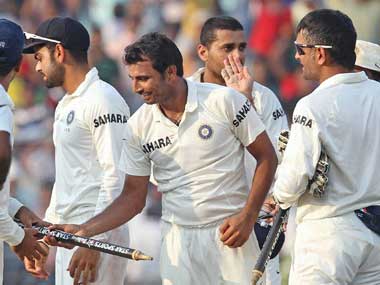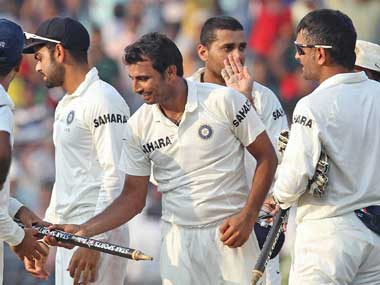2013 is turning out to be a good vintage for Indian Test debutantes. Go back 12 months to include December 2012 and it might even be a great one. Over that span, six players have received their Test caps: Ravindra Jadeja, Bhuvneshwar Kumar, Shikhar Dhawan, Ajinkya Rahane, Mohammad Shami and Rohit Sharma Of those half dozen players, five of them can consider themselves pencilled into the playing XI at the moment, with Rahane being the odd man out. Lately, whatever the Indian selectors touch seems to turn to gold. Rohit and Shami are simply the latest examples. For all the hoopla about Sachin Tendulkar’s 199th Test and some of the embarrassing plans put together by the Cricket Association of Bengal to celebrate him, the Kolkata Test will be remembered for what these two did on the field. Shami gave Dhoni the hammer he had hoped Ishant Sharma would become. Rohit’s debut century not only turned the game around for India, but it was the best debut by an Indian batsman not named Shikhar Dhawan. To put it another way, Rohit scored 39 percent of India’s runs in the match; Shami took 45 percent of the wickets. The intriguing thing about these selections is that they don’t follow a pattern. Sandeep Patil’s committee appears determined to pick the best players for the team without a preconceived formula. [caption id=“attachment_1219697” align=“alignleft” width=“380”]
 Shami has been the latest find by Indian selectors. PTI[/caption] Jadeja had been discarded as a one-day all-rounder, failing to make the 2011 World Cup squad despite numerous opportunities. Two triple-centuries in Ranji Trophy last season earned him a surprise Test call-up against England. His debut Test was uneventful but in his first full series against Australia, he was majestic … with the ball, taking 24 wickets at 17.45 and and turning Michael Clarke into a walking wicket. Suddenly he had become India’s trump card. His potential with the bat allowed Dhoni to move up the order to No 6 and play five bowlers. India won a series 4-0 for the first time in its history. Bhuvneshwar was only 22 when he was picked to play against Pakistan in a three-match ODI series, but had five seasons of first-class cricket under his belt already. His ability to swing the new ball impressed the selectors so much in those three games that he was promptly picked for the Test series against Australia. He has rewarded their faith with early wickets in almost every game he has played, even if he is yet to develop into a wicket-taking threat throughout a five-day game. Dhawan made his ODI debut in 2010 but did not leave a mark. It seemed he was merely passing through. But when Patil and company dropped both Virender Sehwag and Gautam Gambhir, they needed to find new openers. Frustrated by his lack of chances, Dhawan had considered quitting cricket but changed his attitude instead. His blazing 187 against Australia from just 85 balls - the fastest debut century in history – not only sent people scurrying for the record books, but lifted the gloom over Sehwag’s fall. The left-hander has since established himself as one of the world’s most feared ODI openers as well, scoring 991 runs at an average of 55.05 with a strike-rate of 95.84 in 2013. And there is that now famous moustache. Mohammad Shami had played just 15 first-class and 15 List A games when he was parachuted into India’s ODI team to play Pakistan in January earlier this year. He had played just 18 first-class games when he made his Test debut. The selectors simply liked what they saw, experience and track record be damned. This is something Pakistan has done to great effect over the years. Shami showed it can work in India too. Rohit’s story is well worn now. Talent up to his ears, but what was between those ears kept letting him down. A Test cap was his in 2010, then a freak injury took it away. An almost four year wait followed. He was inconsistent, frustrating and unfulfilled. The selectors kept the faith. The coach made him an opener when Sehwag and Gambhir lost their way. Rohit had aged, had tasted the responsibility of captaincy with Mumbai Indians, and was a man transformed. His 177 in Kolkata was a masterpiece of disciplined batting. Rahane is the odd one out in this story. He had to ride the bench for 14 months before getting his Test cap against Australia in the fourth and final game. He failed to seize his chance, scoring just 13 runs, but his remarkable scoring rate in domestic cricket, and his peformances in the IPL for Rajasthan Royals, have kept him in the squad. He has the first-class pedigree, so the selectors continue to back him, which is what every player needs and wants. It is easy for countries to struggle when greats of the game step away. Australia lost Dennis Lillee, Greg Chappell and Rodney Marsh in 1984. The team entered a cricketing wasteland they would not emerge from for five long years. The West Indies is still to recover from losing the greats of the 1980s and 90s. Australia too is struggling once again with the loss of the bulwarks of their most recent all-conquering sides, while Sri Lanka is finding it hard to replace Mahela Jayawardene, Kumar Sangakkara, Muttiah Muralitharan and Chaminda Vaas. For India, VVS Laxman and Rahul Dravid retired last year. Tendulkar will call time on a 24-year career in 10 days. Yet the team does not look like it will crumble. Quite the opposite. It is a young team full of desire and potential, intent on carving out its own identity. Of course, it is early days still. The history of the game is littered with spectacular beginnings that were followed by quick, undignified exits. But for now at least, India is making all the right moves. And that is something to be celebrated.
Shami has been the latest find by Indian selectors. PTI[/caption] Jadeja had been discarded as a one-day all-rounder, failing to make the 2011 World Cup squad despite numerous opportunities. Two triple-centuries in Ranji Trophy last season earned him a surprise Test call-up against England. His debut Test was uneventful but in his first full series against Australia, he was majestic … with the ball, taking 24 wickets at 17.45 and and turning Michael Clarke into a walking wicket. Suddenly he had become India’s trump card. His potential with the bat allowed Dhoni to move up the order to No 6 and play five bowlers. India won a series 4-0 for the first time in its history. Bhuvneshwar was only 22 when he was picked to play against Pakistan in a three-match ODI series, but had five seasons of first-class cricket under his belt already. His ability to swing the new ball impressed the selectors so much in those three games that he was promptly picked for the Test series against Australia. He has rewarded their faith with early wickets in almost every game he has played, even if he is yet to develop into a wicket-taking threat throughout a five-day game. Dhawan made his ODI debut in 2010 but did not leave a mark. It seemed he was merely passing through. But when Patil and company dropped both Virender Sehwag and Gautam Gambhir, they needed to find new openers. Frustrated by his lack of chances, Dhawan had considered quitting cricket but changed his attitude instead. His blazing 187 against Australia from just 85 balls - the fastest debut century in history – not only sent people scurrying for the record books, but lifted the gloom over Sehwag’s fall. The left-hander has since established himself as one of the world’s most feared ODI openers as well, scoring 991 runs at an average of 55.05 with a strike-rate of 95.84 in 2013. And there is that now famous moustache. Mohammad Shami had played just 15 first-class and 15 List A games when he was parachuted into India’s ODI team to play Pakistan in January earlier this year. He had played just 18 first-class games when he made his Test debut. The selectors simply liked what they saw, experience and track record be damned. This is something Pakistan has done to great effect over the years. Shami showed it can work in India too. Rohit’s story is well worn now. Talent up to his ears, but what was between those ears kept letting him down. A Test cap was his in 2010, then a freak injury took it away. An almost four year wait followed. He was inconsistent, frustrating and unfulfilled. The selectors kept the faith. The coach made him an opener when Sehwag and Gambhir lost their way. Rohit had aged, had tasted the responsibility of captaincy with Mumbai Indians, and was a man transformed. His 177 in Kolkata was a masterpiece of disciplined batting. Rahane is the odd one out in this story. He had to ride the bench for 14 months before getting his Test cap against Australia in the fourth and final game. He failed to seize his chance, scoring just 13 runs, but his remarkable scoring rate in domestic cricket, and his peformances in the IPL for Rajasthan Royals, have kept him in the squad. He has the first-class pedigree, so the selectors continue to back him, which is what every player needs and wants. It is easy for countries to struggle when greats of the game step away. Australia lost Dennis Lillee, Greg Chappell and Rodney Marsh in 1984. The team entered a cricketing wasteland they would not emerge from for five long years. The West Indies is still to recover from losing the greats of the 1980s and 90s. Australia too is struggling once again with the loss of the bulwarks of their most recent all-conquering sides, while Sri Lanka is finding it hard to replace Mahela Jayawardene, Kumar Sangakkara, Muttiah Muralitharan and Chaminda Vaas. For India, VVS Laxman and Rahul Dravid retired last year. Tendulkar will call time on a 24-year career in 10 days. Yet the team does not look like it will crumble. Quite the opposite. It is a young team full of desire and potential, intent on carving out its own identity. Of course, it is early days still. The history of the game is littered with spectacular beginnings that were followed by quick, undignified exits. But for now at least, India is making all the right moves. And that is something to be celebrated.
Tariq Engineer is a sports tragic who willingly forgoes sleep for the pleasure of watching live events around the globe on television. His dream is to attend all four tennis Grand Slams and all four golf Grand Slams in the same year, though he is prepared to settle for Wimbledon and the Masters.
)